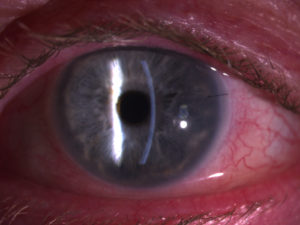Descemet’s Membrane Endothelial Keratoplasty (DMEK)
What is DMEK?
Descemet’s Membrane Endothelial Keratoplasty (DMEK) is a type of endothelial keratoplasty in which only Descemet’s membrane itself and endothelium are inserted into the eye.
How is DMEK performed?
The DMEK procedure involves stripping the diseased back layer from the recipient cornea and inserting a circle of Descemet’s membrane and endothelium from a donor cornea into the eye through a tiny incision. A bubble of air is placed into the front chamber of the eye to force the donor layer on to the back of the cornea and it will stick there by itself. The healthy endothelium will then start working to pump the swollen cornea clear again. Usually, just one suture is required to close the incision.
DMEK has a number of potential advantages over full-thickness transplants. Healing is much faster and the problem of high degrees of astigmatism and defocus that occurs with full-thickness grafts is avoided. There is also less disturbance to the surface of the eye and fewer dry eye problems and there is a lower chance of rejection. With the DMEK procedure the potential improvement in vision is up to 20/20 (6/6) if the rest of the eye is healthy.
The surgery is done as a daycase or overnight stay procedure under general or local anaesthetic with sedation. The operation takes about an hour. It is often combined with cataract surgery if that has not already been done.
What is the recovery like?
One of the most difficult aspects of the surgery is that it is necessary to lie completely flat most of the time afterwards for several days to position the bubble of air in the eye underneath the transplant to stick the graft to the back of your cornea. About one in twenty times the graft does not stick fully. In that case it is necessary to place another bubble of air in the eye and do more lying flat at some stage in the 2 weeks after surgery. This may be done in the clinic or back in the operating theatre. Occasionally this has to be repeated more than once. One in a hundred or so cases, the transplanted endothelium does not work or the graft is wrinkled and even it it is in the right position it needs to be removed and replaced with a new graft. A decision about doing this is usually made about a month after the initial surgery.
Often the corneal epithelium (surface cells of the cornea) will be removed during the procedure as it is usually loose and unstable when the cornea is swollen. A bandage contact lens is then placed in the eye at the end of the procedure and this will stay in until the surface has healed (usually a week or so). The surface healing can be more prolonged if the cornea has been swollen for a long time. If this is done then it is usually more uncomfortable for longer after the procedure and recovery of vision takes longer.
Recovery of vision is very variable after DMEK and depends on many factors, e.g. how swollen the cornea was to start with and for how long. Generally, vision takes some weeks to really start improving and then many months to get as good as it is going to. It may be 3 to 6 months before vision is stable enough to have glasses changed.
Are there any problems that can occur?
There are many potential problems with corneal transplant surgery of any type.
This is a transplant of living tissue into the eye and your immune system can reject the transplanted tissue. You will be using steroid drops in the eye to prevent this for at least 2 years after surgery. It is very important to keep using these drops. If the transplanted cornea rejects then your cornea will become swollen again and another graft will need to be done.
Some people will have a rise in intraocular pressure due to the steroid drops. That may require treatment with drops to keep the pressure at a normal level. Rarely, surgery may be required for this. This is less likely for DMEK than for other types of corneal transplant.
Those people who have not already had cataract surgery may develop cataract after the DMEK procedure and that will require surgery when vision is significantly affected.
You do need to be aware that, even though the transplanted tissue is carefully screened, there is a remote risk of having some sort of infection transmitted by the surgery.
For those people who have a very swollen cornea or where it has been swollen for a long time it is common to have issues with the healing and stability of the corneal epithelium (surface of the cornea) in the first several weeks after surgery.
How long will it last?
The transplanted cornea will not last forever. It is not yet known how long endothelial grafts will last in general. The full-thickness grafts done for the same reasons can last up to 25 years but many fail before then and the cornea swells up again. About 80 per cent of grafts last at least 5 years. If the DMEK graft fails then it can be removed and replaced with another graft.


